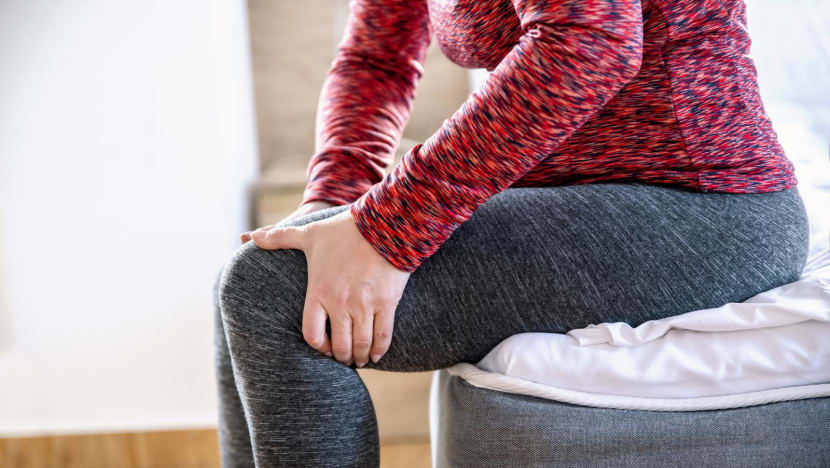Study finds joint and muscle pain top menopausal symptom for women in Singapore
Despite such pains being common complaints from women experiencing menopause, little research has been done on the cause and risk factors associated with the condition.

A woman suffering from knee pain. (Photo: iStock)

This audio is generated by an AI tool.
SINGAPORE: Pain in the joint and muscles is the top symptom affecting Singaporean women going through menopause, said researchers.
Studies found more than two-thirds of midlife women have suffered from some form of the condition known as arthralgia, ranging from mild to very severe aches or pains.
Researchers said the findings were surprising as they differ from studies done in the West.
“Women in the West cite vasomotor symptoms (commonly known as hot flushes) as the top menopausal issues they face, while joint pain is in number five,” said Professor Yong Eu Long, an emeritus consultant at the National University Hospital’s Department of Obstetrics and Gynaecology.
Hence, while hot flushes have been widely studied, relatively little attention has been given to arthralgia, he said.
“Despite arthralgia being one of the most frequent complaints, there is a paucity of studies examining the risk factors associated with this condition,” Prof Yong told CNA’s Singapore Tonight on Monday (Jan 15).
ARTHRALGIA A TOP MENOPAUSAL SYMPTOM
Researchers from NUH’s Integrated Women’s Health Programme (IWHP) and the National University of Singapore’s Yong Loo Lin School of Medicine (NUS Medicine) conducted two studies on menopausal symptoms last year, focused on Chinese, Malay and Indian women – the three main races in Singapore.
The first study found that 62.6 per cent of 1,054 women reported at least one moderate to extremely severe arthralgia symptom during their menopause.
Some 32.9 per cent of respondents cited joint and muscular discomfort as the top symptom which significantly affected them.
Other symptoms included sleep problems at 27.5 per cent, vaginal dryness at 20.3 per cent, and physical and mental exhaustion at 19.6 per cent. Hot flushes, the symptom most commonly associated with menopause, was fifth at 18.6 per cent.
A second study of 1,120 women yielded similar results, with about 75 per cent of respondents suffering from some form of arthralgia. A majority experienced joint and muscle pains in the postmenopausal period.
OESTROGEN COULD BE A FACTOR
The condition could be due to a lack of oestrogen, said Prof Yong.
He drew a comparison with breast cancer patients who suffer the same joint pain symptoms after taking an oestrogen inhibitor. Such inhibitors reduce the amount of oestrogen in the body to deprive breast cancer cells of the hormones they need to grow.
“By lowering oestrogen with this drug, they also have joint pain, which exactly mimics what we find in our healthy menopausal women. And when the patients stop this drug for their breast cancer therapy, their joint pain disappears. So there appears to be a link,” he said.
Oestrogen protects joints and reduces inflammation. Hence, joints can swell as oestrogen levels decline during menopause.
“During menopause, the skin dries up and fluid around the joints similarly shrinks. Muscles are also weakened. The joints rub against each other and cause pain,” said Prof Yong.
Commonly used joints such as those around the fingers, shoulders, knees and on the back are the most frequently affected.
The condition is associated with other menopausal symptoms including vaginal dryness, physical and mental exhaustion as well as poor muscle strength.
MORE RESEARCH IN THE WORKS
Prof Yong said the findings underscore the necessity of conducting such studies locally to understand and manage the symptoms experienced by Singaporean women.
Despite such pains being common complaints from women experiencing menopause, little research has been done on the cause and risk factors associated with the condition.
“Menopausal arthralgia is a condition that even clinicians globally are not well aware of,” he said. “Filling these gaps will help understand the burden of arthralgia and its associated factors … and may shed understanding on improving its management.”
Menopausal joint and muscle pain have often been mistaken as an inevitable part of the ageing process.
Madam Amy Fang, a participant in the study who has endured a decade of arthralgia, said the condition has caused her excruciating discomfort, including in her spine and nerves, hindered her ability to perform basic daily tasks, and significantly affected her quality of life.
“It was first presented to me as (a symptom of ageing) and told there isn’t anything I can do. Nobody told me that it could possibly be linked with menopause. It was a very difficult journey because no one understood the pain I was going through,” she said.
She is among an increasing number of women seeking treatment at NUH for menopausal symptoms. The hospital said patients with such symptoms have significantly increased over the years due to the ageing population and greater awareness.
Prof Yong said exercises that strengthen the muscles will help to ease tension and stress on the joints.
“Joint pains are associated with weak muscles. Proper strengthening of the muscles will help to protect the joints,” he explained.
Studies are also in the works to develop targeted interventions, he said. They include exercise regimes to enhance muscle strength and exploring menopausal hormone therapy's potential in alleviating pain.
“We are planning a study to see whether hormones and exercise, whether alone or in combination, can help the situation and hopefully help those like Mdm Fang get a better quality of life.”


















